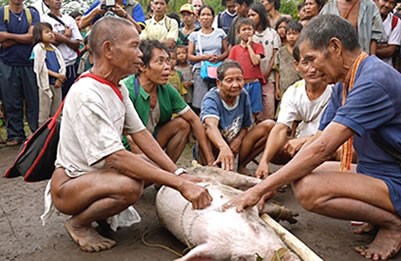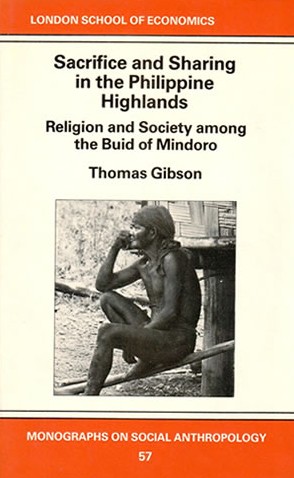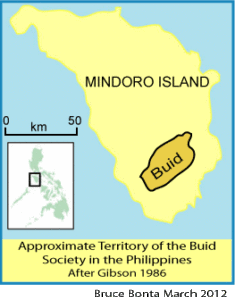Location. About 4000 Buid live in the highlands of Mindoro Island in the Philippines.

Economy. The Buid subsist primarily on shifting farming and on trade with the outside world. Among themselves, they dislike economic transactions that might put one person in debt to another, even temporarily. They view calculations of equivalent value and reciprocity as completely incompatible with their egalitarian ethos, so they avoid individual barter. They do not tolerate economic relationships that place people in situations of competition, in which one or the other must lose. They do, however, have a long history of trading pottery, baskets, and resin with the outside world in order to obtain articles that are essential to their economy, such as iron blades, cloth, and salt.
Beliefs that Foster Peacefulness. The Buid believe that the spirit world serves as a model to explain the social world in which they live. The hostility between the Buid and their Christian lowland neighbors is represented mystically by hostilities between spirit familiars and predatory spirits. The sharing, supportive relationships within the Buid communities are represented by the linkages between them and the earth spirits. Thus, within the context of predatory aggression by lowlanders and spirits, the Buid maintain their peaceful, tranquil communities. The Buid see themselves as part of a mystical continuum in which pigs eat passive plants, people have to commit aggression against pigs and eat them in rituals which attempt to control the dangers from predatory spirits, and the spirits eat people.
Avoiding and Resolving Conflict. Social conflict is resolved by the means of collective discussions, called tultulans, in which community members assemble to hear grievances and resolve conflicts. If the proceedings don’t work and a couple, for instance, needs to separate, the spouse who has been abandoned is entitled to compensation, which the tultulan will set. A spouse who is aggressive, jealous or possessive is condemned by the group, but infidelity is not. Thus the tultulan and compensation procedures normally diffuse potential conflicts into compromises.

Gender Relations. The Buid social and moral order is based on the symbolism of companionship, particularly the closely cooperative marriages, though they do go through many marriages, one after the other. Both spouses own their separate swidden patches and valuables, but they share in the ownership of their house and animals, which symbolize the unity of the couple. They cooperate in their agricultural and domestic chores, though the husbands tend to perform more of the heavy tasks and the wives more of the lighter, repetitive chores. The men and women periodically wrestle together on moonlit nights, in semi-ritualistic gang fights in which the men reach up the women’s skirts, and the women fight back by ganging up on a man, grappling with him and grabbing for his genitals.
Raising Children. The Buid do not order children to do things or punish them. If directly asked to do something, a child may indicate unwillingness, which is a way of asserting its own autonomy, though the child may subsequently carry out the request after enough time has lapsed. Children who are particularly quarrelsome and anti-social, or who have tantrums, are cured through exorcisms of the evil spirits that have caused the problems. These serve to distance the children from their anti-social behavior, involve no loss of face, and encourage them to assume self-control. The Buid community is noted for supporting schools that instill peaceful traditions in their children in the context of teaching modern subjects.
Social Practices. The Buid avoid dyadic relationships as much as possible. When two individuals converse, they do not face one another or address comments or questions directly to the other person; instead, they may sit facing the same direction, or back-to-back, making comments that the other person may or may not respond to, depending on whether he or she agrees. Rather than contradicting the speaker, the listener may make his or her own comments on different subjects, to which the first speaker may respond or change the subject again in turn. A 2013 update about the strategies the Buid use to maintain their peacefulness argues that their pacifism is a reaction to persecution by aggressive lowlanders.
Cooperation and Competition. When they are preparing to engage in cooperative agricultural tasks such as slashing, burning, planting, or harvesting, the community will get together, everyone squatting and facing in the same direction, perhaps concentrating on a distant mountain. Each person will address the group and indicate his or her need for assistance; if conflicts are perceived, the parties will talk them out. But individuals do not address each other: instead, all individual comments are made to the group as a whole. Since the speaker is always an individual and the listener a group, clashes of wills are avoided; avoiding social interaction between symmetrical units such as individuals minimizes competition and possible confrontations.

Sharing. Sharing occurs in a Buid village when a family sacrifices a chicken or pig, either due to illness or a death in the family. The family carefully shares the meat equally with every other family in the community. But even then, the individual family is sharing with the whole community, not with another specific family, so no direct obligation is made. Of course every family receives ritually shared portions of meat frequently from others in the village.
Strategies for Avoiding Warfare and Violence. For the Buid, physical violence is the product of boasting, quarreling, expression of emotions, egotistical self-assertion, and aggression, all of which have highly negative values. They prefer to avoid violence through withdrawal. They emphasize their fear, their flight from danger. They place a negative value on concepts such as bravery or courage. Young Buid men completely ignore acts of courage and learn love poems to court women. They have preserved an ancient script which they use to help memorize poems, which are filled with gentle images.
But How Much Violence Do They Really Experience? Violence does occur, though rarely, in Buid villages, particularly when circumstances have marginalized traditional values and conflict resolution techniques. Gibson (1986) cites one incident where an aggressive Buid man was pressed for divorce by his wife, who said that he beat her frequently. The dispute was not resolved by a traditional tultulan, the husband was humiliated, and a few months later he went back to the home of his wife’s father, killed her, burned the house, and slaughtered the livestock. A few days later he was found dead, a presumed suicide.
More Resources in this Website:
- Faced with expropriation of their lands, the Buid in one community tried using their ancient rituals to appeal to their ancestors for help.
- The baybayin script of the Buid, primarily used for writing love poetry, is in danger of being forgotten, but some artists and elders are preserving it.
- The Buid recite their ambahan poetry to assert their unity and sense of determination in the face of threats from miners and soldiers.
- Young Buid have mostly abandoned an important symbol of their culture—the loincloth.
Sources in Print: Gibson 1985, 1986, 1988, 1989, 1990
Sources on the Web: Mangyan Heritage Center
Updates—News and Reviews:
Selected Recent Stories
December 25, 2014. A Congressman Champions the Buid
March 27, 2014. Philippine Conference Promotes Indigenous Languages
January 16, 2014. The Tamaraw and the Buid
December 26, 2013. Buid Begging
All Stories
All stories in this website about the Buid are listed in the News and Reviews Subject Listing
